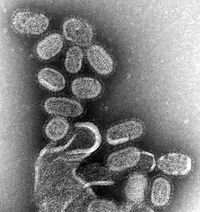
Photo from wikipedia
Abstract Sialic acids are used as a receptor by several viruses and variations in the linkage type or C-5 modifications affect the binding properties. A species barrier for multiple viruses… Click to show full abstract
Abstract Sialic acids are used as a receptor by several viruses and variations in the linkage type or C-5 modifications affect the binding properties. A species barrier for multiple viruses is present due to α2,3- or α2,6-linked sialic acids. The C-5 position of the sialic acid can be modified to form N-acetylneuraminic acid (Neu5Ac) or N-glycolylneuraminic acid (Neu5Gc), which acts as a determinant for host susceptibility for pathogens such as influenza A virus, rotavirus, and transmissible gastroenteritis coronavirus. Neu5Gc is present in most mammals such as pigs and horses but is absent in humans, ferrets, and dogs. However, little is known about C-5 content in wildlife species or how many C-5 modified sialic acids are present on N-linked glycans or glycolipids. Using our previously developed tissue microarray system, we investigated how 2 different lectins specific for Neu5Gc can result in varying detection levels of Neu5Gc glycans. We used these lectins to map Neu5Gc content in wild Suidae, Cervidae, tigers, and European hedgehogs. We show that Neu5Gc content is highly variable among different species. Furthermore, the removal of N-linked glycans reduces the binding of both Neu5Gc lectins while retention of glycolipids by omitting methanol treatment of tissues increases lectin binding. These findings highlight the importance of using multiple Neu5Gc lectins as the rich variety in which Neu5Gc is displayed can hardly be detected by a single lectin.
Journal Title: Glycobiology
Year Published: 2022
Link to full text (if available)
Share on Social Media: Sign Up to like & get
recommendations!